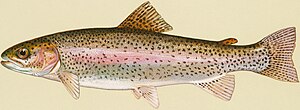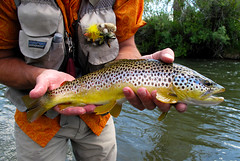Trout SpeciesRainbow trout are far and away the most common trout in the
Ozarks. Every trout stream in the region holds at least a decent population of rainbows, and they?re the predominant species in most Ozark streams. The
Missouri Department of Conservation and the Arkansas Game and Fish Commission stock literally millions of rainbows each year. Also, they reproduce well in most trout streams here. They readily take spinners, spoons, nymphs, and various dry flies. Some seem extremely gullible, and easy to catch, but there are plenty of well educated specimens that require perfect presentation, and a good deal of luck to bring to net.
Brown trout are the proverbial "bullies" of the Ozark streams. While they are usually fewer in number than rainbows, they often take up most of the prime water, relegating the inferior water to other trout species. The trophy sized browns tend to be aggressive, more likely to strike a Rapala or a big streamer than a dainty dry fly. Smaller browns generally respond to the same techniques that produce rainbows. Brown trout tend to be more wary than other trout species, and generally require good technique. All of the
Ozark tailwaters are good bets for trophy browns. The freestone streams may not hold as large of browns, but they make up for it in numbers. As a general rule, many or most browns caught from a tailwater will be wild fish, while freestone browns are always stocked.
 Image via Wikipedia
Image via Wikipedia
Brook trout are often overlooked in the Ozarks. Only found in the
Arkansas tailwaters (besides a small remnant population in the Spring River and several other small streams), these are probably the prettiest trout to be found in the area. They also tend to be relatively easy to catch, responding well to dry flies and nymphs, as well as spinners and spoons. Brook trout run much larger in the Ozarks than they do elsewhere, averaging between 12" and 14". Some trophy sized brooks up to 20" can be found. While all of the Arkansas tailwaters hold good populations of Brook trout, the best numbers will always be found the first 10 mile below the dam. The entire Norfork tailwater is a great bet for big brookies. There has been some reported natural spawning of brook trout, but they must be stocked to maintain fishable numbers.
 Image by Fool-On-The-Hill via Flickr
Image by Fool-On-The-Hill via Flickr
Like Brook trout, Cutthroats are for the most part found only found in the
tailwaters of Arkansas, although there is also a good population found in the Spring River. They're not difficult to catch, but good populations are only found in the first 15 or 20 miles below the dams, and in the first 5 miles below Mammoth Spring on the Spring River. Nothing makes you feel like your out west more than hooking cutthroat after cutthroat on a big dry fly. And that's very possible on all of the tailwaters, as cutthroat tend to be very willing to rise to dries (even when there's not actually a hatch occurring), especially during low water. The Little Red below Greers Ferry Dam may be the best bet for those targeting cutthroat. The Norfork and
Bull Shoals tailwaters are close behind. Cutthroat trout populations are maintained by stocking.
These are the most common species of trout found in the Ozarks. While other species can be found sporadically from occasional stockings (Golden trout and Lake Trout being examples), these four are the only ones your likely to catch. All of these trout have many similarities, but they are different in some very special ways.
 Image via Wikipedia
Image via Wikipedia Image by CircumerroStock via Flickr
Image by CircumerroStock via Flickr Image via Wikipedia
Image via Wikipedia Image by Fool-On-The-Hill via Flickr
Image by Fool-On-The-Hill via Flickr![Reblog this post [with Zemanta]](http://img.zemanta.com/reblog_e.png?x-id=d3e4a2b7-6420-4e15-87f6-8993b9d18f71)




No comments:
Post a Comment